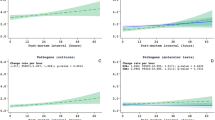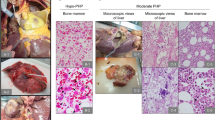Abstract
In cases of sudden unexpected death in infants and children (SUDI), microbiological investigation has been an important part of the autopsy protocol at the University of Oslo for the last 15 years. The purpose of this study was to compare the microbiological findings in samples taken at hospital admittance shortly after death and at autopsy. Blood cultures and cerebrospinal fluid (CSF) were collected both at the hospital and at autopsy; organ samples were additionally collected at autopsy. Hospital samples were collected at a median of 4.5 h (95% confidence interval [CI] 3.25–5) and autopsy samples at a median of 24.25 h (95% CI 22–25.5) after death. The proportion of positive cultures was stable over time; the post mortal time had no influence on bacterial growth. As long as the autopsy is performed within 48 h after death, prior microbiological examination is unnecessary. Blood culture, CSF and lung specimens are the best predictors in our study.

Similar content being viewed by others
Reference
Centers for Disease Control and Prevention (CDC) (1996) Guidelines for death scene investigation of sudden, unexplained infant deaths: recommendations of the Interagency Panel on Sudden Infant Death Syndrome. MMWR Morb Mortal Wkly Rep 45:1–22
Krous HF (1995) The international standardized autopsy protocol for sudden unexpected infant death. In: Rognum TO (ed) Sudden infant death syndrome: new trends in the nineties. Scandinavian University Press, Oslo, pp 81–95
Gaustad P, Holter E, Vege A (2004) Bacteriological and virological examination in cases of sudden unexpected deaths in infancy and early childhood. Scand J Forensic Sci 10:72
Rognum TO, Arnestad M, Bajanowski T, Banner J, Blair P, Borthne A, Byard RW, Gaustad P, Gregersen M, Grøgaard J, Holter E, Isaksen CV, Jørgensen JV, Krous HF, de Lange C, Moore I, Mørland J, Opdal SH, Råsten-Almqvist P, Schlaud M, Sidebotham P, Skullerud K, Stoltenburg-Didinger G, Stray-Pedersen A, Sveum L, Vege Å (2003) Consensus on diagnostic criteria for the exclusion of SIDS. Nord Rettsmedisin 9:62–73
Bajanowski T, Vege Å, Byard RW, Krous HF, Arnestad M, Bachs L, Banner J, Blair PS, Borthne A, Dettmeyer R, Fleming P, Gaustad P, Gregersen M, Grøgaard J, Holter E, Isaksen CV, Jorgensen JV, de Lange C, Madea B, Moore I, Morland J, Opdal SH, Råsten-Almqvist P, Schlaud M, Sidebotham P, Skullerud K, Stoltenburg-Didinger G, Stray-Pedersen A, Sveum L, Rognum TO (2007) Sudden infant death syndrome (SIDS)—standardised investigations and classification: recommendations. Forensic Sci Int 165:129–143. doi:10.1016/j.forsciint.2006.05.028
Sadler DW (1998) The value of a thorough protocol in the investigation of sudden infant deaths. J Clin Pathol 51:689–694. doi:10.1136/jcp.51.9.689
Gregersen M, Rajs J, Laursen H, Baandrup Gidlund E, Helweg-Larsen K, Hirvonen J, Isaksen CV, Kock K, Lundemose JB, Løberg EM, Rognum TO, Skullerud K, Vege Å (1995) Pathologic criteria for the Nordic study of SIDS. In: Rognum TO (ed) Sudden infant death syndrome: new trends in the nineties. Scandinavian University Press,Oslo, pp 50–58
Krous HF, Beckwith JB, Byard RW, Rognum TO, Bajanowski T, Corey T, Cutz E, Hanzlick R, Keens TG, Mitchell EA (2004) Sudden infant death syndrome and unclassified sudden infant deaths: a definitional and diagnostic approach. Pediatrics 114(1):234–238. doi:10.1542/peds.114.1.234
Vege A, Rognum TO (1997) Use of new Nordic criteria for classification of SIDS to re-evaluate diagnoses of sudden unexpected infant death in the Nordic countries. Acta Paediatr 86(4):391–396. doi:10.1111/j.1651-2227.1997.tb09029.x
Morris JA, Harrison LM, Partridge SM (2006) Postmortem bacteriology: a re-evaluation. J Clin Pathol 59:1–9. doi:10.1136/jcp.2005.028183
Tsokos M, Püschel K (2001) Postmortem bacteriology in forensic pathology: diagnostic value and interpretation. Leg Med (Tokyo) 3:15–22. doi:10.1016/S1344-6223(01)00002-5
Roberts FJ (1998) Procurement, interpretation, and value of postmortem cultures. Eur J Clin Microbiol Infect Dis 17:821–827. doi:10.1007/s100960050200
Davis BD, Dulbecco R, Eisen HN, Ginsberg HS (1980) Microbiology, 3rd edn. Harper & Row, New York
Lærebok i rettsmedisin (2001) Gyldendal Akademisk, Oslo
Norris C, Pappenheimer AM (1905) A study of pneumococci and allied organisms in human mouths and lungs after death. J Exp Med 7:450–472. doi:10.1084/jem.7.5.450
Morris JA, Harrison LM, Partridge SM (2007) Practical and theoretical aspects of postmortem bacteriology. Curr Diagn Pathol 13:65–74. doi:10.1016/j.cdip.2006.07.005
Arnestad M, Vege A, Rognum TO (2002) Evaluation of diagnostic tools applied in the examination of sudden unexpected deaths in infancy and early childhood. Forensic Sci Int 125:262–268. doi:10.1016/S0379-0738(02)00009-9
Rambaud C, Guibert M, Briand E, Grangeot-Keros L, Coulomb-L’Herminé A, Dehan M (1999) Microbiology in sudden infant death syndrome (SIDS) and other childhood deaths. FEMS Immunol Med Microbiol 25:59–66. doi:10.1111/j.1574-695X.1999.tb01327.x
Aranda M, Martí C, Bernet M, Gudiol F, Pujol R (1998) Diagnostic utility of postmortem fine-needle aspiration cultures. Arch Pathol Lab Med 122:650–655
Garges HP, Moody MA, Cotten CM, Smith PB, Tiffany KF, Lenfestey R, Li JS, Fowler VG Jr, Benjamin DK Jr (2006) Neonatal meningitis: what is the correlation among cerebrospinal fluid cultures, blood cultures, and cerebrospinal fluid parameters? Pediatrics 117:1094–1100. doi:10.1542/peds.2005-1132
Weber MA, Klein NJ, Hartley JC, Lock PE, Malone M, Sebire NJ (2008) Infection and sudden unexpected death in infancy: a systematic retrospective case review. Lancet 371:1848–1853. doi:10.1016/S0140-6736(08)60798-9
Author information
Authors and Affiliations
Corresponding author
Additional information
This project has been financed with the aid of EXTRA funds from the Norwegian Foundation for Health and Rehabilitation and the Norwegian SIDS and Stillbirth Society.
Rights and permissions
About this article
Cite this article
Lobmaier, I.V.K., Vege, Å., Gaustad, P. et al. Bacteriological investigation—significance of time lapse after death. Eur J Clin Microbiol Infect Dis 28, 1191–1198 (2009). https://doi.org/10.1007/s10096-009-0762-0
Received:
Accepted:
Published:
Issue Date:
DOI: https://doi.org/10.1007/s10096-009-0762-0




